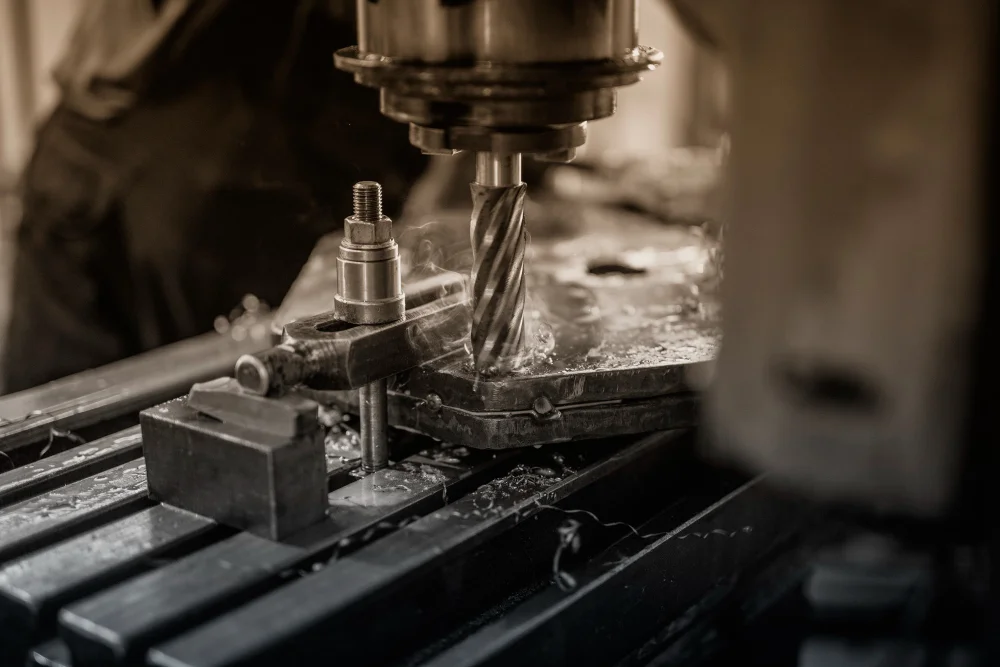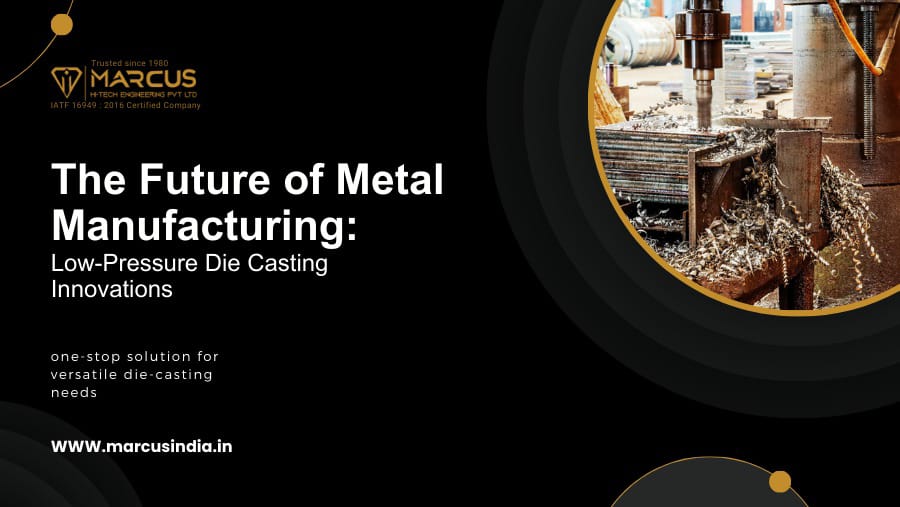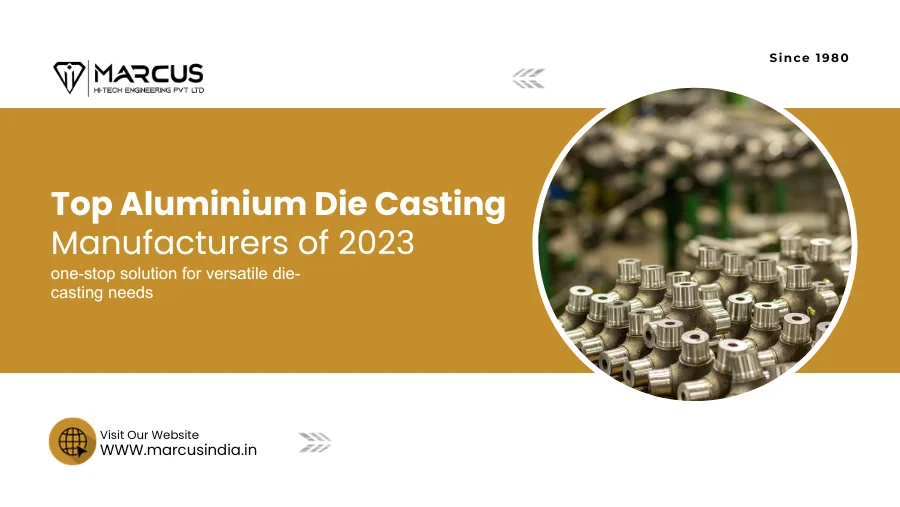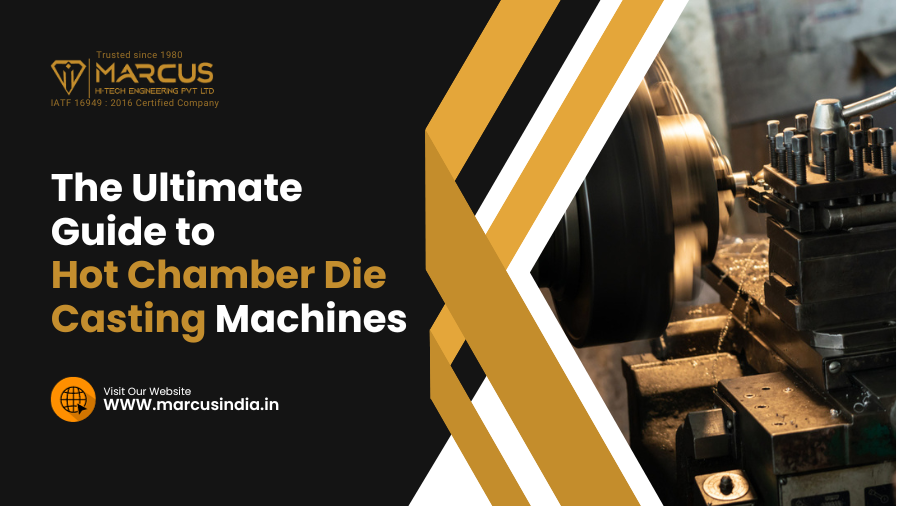
Die casting, a highly efficient and cost-effective manufacturing process has become a cornerstone of the global manufacturing industry. Die casting has witnessed significant growth worldwide with its ability to produce intricate metal parts with exceptional dimensional accuracy and surface finish.
Die casting suppliers in India offer a diverse range of die casting processes to meet the demands of various industries. The industry has experienced remarkable expansion, driven by its robust manufacturing capabilities and the rising demand for high-quality metal components.According to projections, the Die Casting Market will likely hit USD 77.99 billion in 2023, with a steady growth rate of 6.24% leading it to reach USD 105.55 billion by 2028. This growth can be attributed to the flourishing automotive, aerospace, electronics, and industrial sectors, which rely heavily on die casting to produce critical components.
As die casting continues to play a vital role in the Indian manufacturing landscape, it is crucial to understand the various casting processes offered by die casting suppliers in India. These processes, tailored to specific requirements, provide manufacturers with the means to achieve superior results, maintain production efficiency, and meet stringent quality standards.
Let’s delve deeper into each die casting process, its process overviews, advantages, and diverse industrial applications.
Pressure Die Casting

Process
Pressure die casting, also known as high-pressure die casting, is a widely used manufacturing process for producing intricate metal parts. The process involves the following steps:
- Mold Preparation: A reusable steel mold, or die, is prepared by applying a lubricant to ensure easy release of the cast part and prolong the life of the die.
- Injection: Molten metal, typically aluminum, zinc, or magnesium, is melted in a furnace and injected into the die cavity at high speed and pressure using a piston or a plunger. The high pressure ensures that the molten metal fills all the intricate details of the mold.
- Cooling and Solidification: Once the mold cavity is filled, the molten metal is left to cool and solidify, taking the shape of the die. Cooling can be accelerated using cooling channels within the die.
- Ejection: After solidification, the two halves of the die are separated, and the casting is ejected using ejector pins or mechanisms.
- Trimming and Finishing: The castings may undergo trimming or finishing operations to remove any excess material or improve surface quality.
Advantages
- Precision and Dimensional Accuracy: The high pressure exerted during the casting process allows for precise replication of intricate mold details, resulting in excellent dimensional accuracy of the cast parts.
- Efficient Production Rates: Pressure die casting suppliers in India leverage its high production rates, making it suitable for large-scale manufacturing and mass production of parts.
- Cost-Effectiveness: The process allows for the production of complex parts in a single operation, reducing the need for additional machining or assembly operations, thus lowering overall production costs.
- Superior Surface Finish: Pressure die casting produces smooth and consistent surface finish castings, often eliminating the need for additional surface treatments or refinishing operations.
- Design Flexibility: The process allows for the production of complex geometries, including thin walls, intricate details, and undercuts, giving designers and engineers more freedom in part design.
Applications
- Automotive Industry: Engine components, transmission cases, chassis parts, and brackets.
- Aerospace Industry: Turbine blades, structural elements, and aircraft engine components.
- Electronics and Electrical Industry: Housings, heat sinks, connectors, and other intricate components.
- Industrial Equipment: Pump housings, valve bodies, hydraulic and pneumatic components.
- Consumer Goods: Furniture fittings, decorative hardware, appliances.
Vacuum Die Casting

Process
Vacuum die casting is a specialized form of die casting that involves using a vacuum during the casting process. The process is similar to traditional die casting but with the additional step of creating a vacuum environment within the die cavity.
- Mold Preparation: The reusable steel mold, or die, is prepared by applying a lubricant to ensure easy release of the cast part and prolong the life of the die.
- Injection: Molten metal is injected into a die cavity to create castings. Vacuum die casting removes trapped gases for better quality.
- Cooling and Solidification: Molten metal is poured into a mold cavity and left to cool, taking on the shape of the die. Cooling can improve mechanical properties.
- Ejection: After solidification, the two halves of the die are separated, and the casting is ejected using ejector pins or mechanisms.
- Trimming and Finishing: The castings may undergo trimming or finishing operations to remove any excess material or improve surface quality.
Advantages
- Improved Casting Quality: Vacuum die casting produces higher quality and more reliable parts by eliminating porosity and trapped gases.
- Enhanced Mechanical Properties: The controlled cooling process in vacuum die casting allows for improved control over the microstructure and mechanical properties of the casting, leading to enhanced strength and durability.
- Superior Surface Finish: Vacuum die casting produces castings with excellent surface finish, reducing the need for additional surface treatments or refinishing operations.
- Reduction in Defects: The removal of gases and air pockets through vacuum evacuation reduces the occurrence of defects such as shrinkage and air porosity, resulting in higher casting integrity.
Applications
- Automotive Industry: Vacuum die casting suppliers in India make critical components such as engine blocks, cylinder heads, transmission parts, and suspension components.
- Aerospace Industry: Aircraft components, including structural parts, engine components, and landing gear parts, require high strength and integrity.
- Electronics Industry: Heat sinks, electronic housings, and connectors, where precision, quality, and thermal management are crucial.
- Medical Industry: Medical equipment and devices, including surgical instruments, implantable devices, and diagnostic equipment that require high-quality and precise components.
- Energy Sector: For producing components for the energy sector, such as wind turbine parts, solar panel frames, and electrical connectors.
Gravity Die Casting

Process
Gravity die casting or permanent mold casting, is a metal casting process that utilizes the force of gravity to fill a reusable mold cavity with molten metal.
- Mold Preparation: A two-piece mold, typically made of steel or cast iron, is prepared. The mold is preheated to a exact temperature to facilitate metal flow and solidification.
- Mold Coating: The mold cavity is coated with a refractory material or a mold release agent to prevent metal sticking and promote smooth metal flow.
- Pouring: The molten metal, such as aluminum, is poured into the mold cavity using a ladle or a pouring system. Gravity assists in filling the mold cavity.
- Solidification: The molten metal cools and solidifies within the mold cavity, taking the shape of the mold.
- Cooling and Ejection: After sufficient solidification, the casting is cooled further, and the two halves of the mold are separated. The casting is then ejected from the mold.
- Finishing: The castings may undergo trimming, deburring, and other finishing operations to remove any excess material and achieve the desired final shape.
Advantages
- Good Surface Finish: Gravity die casting produces castings with smooth surface finishes and fine details, reducing the need for additional finishing operations.
- Better Mechanical Properties: The controlled cooling process in gravity die casting results in favorable mechanical properties, including improved strength and dimensional stability of the castings.
- Cost-Effective: Gravity die casting is cost-effective, as reusable molds have a longer lifespan and require less maintenance than other casting methods.
- Faster Production: The gravity-filling process allows for shorter production cycles, making it suitable for high-volume production requirements.
- Design Flexibility: Gravity die casting enables the production of complex shapes and thin-walled castings, providing design flexibility to meet specific requirements.
Applications
- Automotive Industry: Used to manufacture automotive components such as engine blocks, cylinder heads, intake manifolds, and suspension parts.
- Lighting Industry: Gravity die casting produces lighting fixtures and components, including lamp housings and reflectors.
- Aerospace Industry: Utilized for producing aircraft components, such as wing fittings, structural parts, and landing gear components.
- Power Generation: Gravity die casting is used for manufacturing components for power generation equipment, including turbine housings, generator casings, and cooling system components.
- General Engineering: Used in various general engineering sectors, producing components for pumps, valves, gearboxes, and other industrial equipment.
Squeeze Die Casting

Process
Squeeze die casting is a specialized form of die casting that involves applying additional pressure to the molten metal during the solidification process. The process includes the following steps:
- Mold Preparation: A reusable steel mold, or die, is prepared by applying a lubricant to ensure easy release of the cast part and prolong the life of the die.
- Injection: Molten metal, typically aluminum or magnesium, is melted in a furnace and injected into the die cavity. The molten metal fills the mold cavity.
- Squeeze Phase: Once the mold cavity is filled, additional pressure is applied to the molten metal. This pressure is maintained during the solidification process to ensure denser and more compact castings.
- Cooling and Solidification: The molten metal cools and solidifies within the die cavity, taking the shape of the die. The controlled cooling process allows solid casting to form with improved mechanical properties.
- Ejection: After solidification, the two halves of the die are separated, and the casting is ejected using ejector pins or mechanisms.
Advantages
- Improved Mechanical Properties: Increasing pressure during solidification results in denser and stronger castings with enhanced mechanical properties.
- Reduction of Porosity: The increased pressure applied during squeeze die casting helps to reduce the presence of porosity in the castings. This results in improved casting integrity and decreased defects risk, enhancing the parts’ overall quality.
- Dimensional Accuracy: Squeeze die casting allows for better control over dimensional accuracy. The application of pressure helps to minimize shrinkage and distortion during solidification, resulting in precise and consistent dimensions of the cast parts.
- Enhanced Part Strength: The denser and more compact structure achieved through squeeze die casting contributes to higher part strength. This is particularly beneficial for applications where structural integrity and load-bearing capabilities are crucial.
- Waste Reduction: The improved casting density and reduced presence of porosity in squeeze die casting lead to less material wastage. This contributes to cost savings and more sustainable manufacturing practices.
Applications
- Automotive Industry: Used for critical automotive components, including engine blocks, cylinder heads, transmission parts, and structural components that require high strength and dimensional accuracy.
- Aerospace Industry: Employed in producing aircraft components such as wing ribs, structural parts, and engine components.
- Defense Industry: Defense-related components such as weapons, ammunition, and military vehicle parts require superior mechanical properties and reliability.
- Electrical and Electronics Industry: Used in producing electrical and electronic components, including connectors, heat sinks, and housings, where dimensional accuracy, thermal management, and electrical conductivity are crucial.
- Industrial Machinery: Components for industrial machineries, such as pump bodies, valve bodies, and hydraulic system components that require high strength, durability, and precise dimensions.
Low-Pressure Die Casting

Process
Low-pressure die casting is a metal casting process that utilizes low pressure to fill a reusable mold cavity with molten metal.
- Mold Preparation: A reusable steel mold, also known as a die, is prepared and preheated to a specific temperature.
- Mold Coating: The mold cavity is coated with a refractory material or a mold release agent to promote smooth metal flow and prevent sticking.
- Clamping: The mold is clamped securely to prevent any leakage during the casting process.
- Molten Metal Injection: A furnace melts metals like aluminum and magnesium, which are poured into a shot chamber after being transferred to a holding furnace.
- Pressurization: Low-pressure gas, like nitrogen, is used to fill a mold cavity with precision by compelling molten metal to flow into the pit.
- Solidification: The molten metal cools and solidifies within the mold cavity, taking the shape of the die.
- Cooling and Ejection: After solidification, the mold is opened, and the casting is ejected. The casting is then cooled further to achieve its final mechanical properties.
Advantages
- Improved casting quality with reduced porosity and structural defects.
- Enhanced mechanical properties like strength and flexibility.
- High dimensional accuracy and better surface finish.
- Design flexibility for complex shapes and intricate details.
Applications
- Automotive components (engine blocks, transmission cases)
- Aerospace parts (turbine blades, structural elements)
- Energy sector equipment (turbines, generators)
- Industrial machinery components (pump bodies, valve bodies)
- Consumer goods (furniture fittings, kitchen appliances)
Also Check: A Comprehensive Guide to Cold Chamber Die Casting Process
Final Words
Overall, die casting suppliers in India provide the most common die casting processes to cater to specific needs and applications. The most commonly used method is pressure die casting due to its versatility and high production rates. However, there are other methods available such as gravity die casting, low-pressure die casting, squeeze die casting, and vacuum die casting, which offer enhanced casting integrity and dimensional accuracy to meet specialized requirements.
FAQs
There are several different methods of die casting, each suited to specific manufacturing needs and material requirements. The primary methods of die casting include:
Cold Chamber Die Casting: In this method, the molten metal is ladled into a cold chamber where a hydraulically operated plunger forces the metal into the die cavity. Cold chamber die casting is commonly used for alloys with high melting points, such as aluminum, copper, and magnesium.
Hot Chamber Die Casting: This method is suitable for alloys with lower melting points, primarily zinc and some magnesium alloys. In hot chamber die casting, the metal is melted within the casting machine itself and then injected into the die cavity by a hydraulic piston.
Gravity Die Casting: Also known as permanent mold casting, gravity die casting relies on the force of gravity to fill the die cavity with molten metal. This method is commonly used for alloys like aluminum and copper and is often employed for casting components with thicker walls.
Low-Pressure Die Casting: In low-pressure die casting, the metal is forced into the die cavity at low pressure using a pressurized gas or mechanical means. This method is ideal for producing parts with complex shapes and thin walls while maintaining high-quality surface finishes.
Squeeze Die Casting: Squeeze die casting combines aspects of both high-pressure and low-pressure methods. It involves injecting molten metal into a die cavity and then applying pressure to the molten metal while it solidifies. This technique is used for intricate parts requiring tight tolerances.
Vacuum Die Casting: Vacuum die casting is used to reduce porosity and improve the quality of die-cast parts. It involves creating a vacuum in the die cavity before injecting molten metal. This removes trapped air and gases, resulting in high-quality, low-porosity components.
Semi-Solid Die Casting: Also known as thixocasting, this method uses a partially solidified, semisolid slurry of metal rather than fully liquid metal. The semisolid material is injected into the die cavity, producing parts with excellent mechanical properties and reduced shrinkage.
The two primary types of die casting machines are:
Hot Chamber Die Casting Machine: In a hot chamber die casting machine, the molten metal is stored in a furnace connected directly to the machine. This molten metal is then injected into the die cavity using a piston. Hot chamber machines are typically used for metals with low melting points, such as zinc, tin, and lead, as they do not corrode or erode the machine’s components easily.
Cold Chamber Die Casting Machine: Cold chamber die casting machines are employed when working with metals with higher melting points, such as aluminum, brass, and magnesium. In this type of machine, the molten metal is kept in a separate furnace, and a ladle is used to transfer the molten metal into the cold chamber. A plunger then injects the metal into the die cavity. Cold chamber machines are favored for their ability to handle a wider range of materials and their resistance to corrosion from high-temperature metals.
There are several different types of die materials used in various manufacturing and industrial processes. The choice of die material depends on factors such as the application, material being processed, and desired results. Here are some common types of die materials:
Tool Steel: Tool steel is a versatile and widely used die material due to its durability, hardness, and resistance to wear and abrasion. It is suitable for a wide range of applications, including metal forming and cutting.
Carbide: Carbide dies are known for their exceptional hardness and resistance to wear. Tungsten carbide is a popular choice for dies in high-stress applications, such as metal stamping and wire drawing.
High-Speed Steel (HSS): HSS is another type of steel that contains various alloying elements to enhance its hardness and wear resistance. HSS dies are often used for cutting and shaping operations at elevated speeds.
Diamond: Diamond dies are among the hardest and most durable die materials available. They are commonly used for precision wire drawing applications where an extremely smooth finish is required.
Ceramics: Ceramics, such as alumina and zirconia, are used in die manufacturing for their high-temperature resistance, electrical insulating properties, and wear resistance. They are often employed in the semiconductor and electronics industries.
Polycrystalline Diamond (PCD): PCD is a composite material made of diamond particles embedded in a metal matrix. PCD dies offer excellent wear resistance and are used for cutting and machining non-ferrous materials like aluminum and composites.
Hardenable Tool Steels: These steels can be heat-treated to achieve high hardness and wear resistance. Common examples include D2, A2, and O1 tool steels, which are used in various die applications.
Rubber and Elastomers: For softer materials like rubber, elastomeric dies made from materials like silicone are employed. These dies are suitable for shaping and cutting rubber components.
Plastic: For plastic molding and extrusion, dies made from materials like hardened steel or specialized plastics are used. These dies need to withstand the high temperatures and pressures involved in plastic processing.
Composite Materials: Some dies are constructed from composite materials, combining the advantages of different substances. For example, a die may consist of a carbide insert within a steel body for enhanced performance.
Die casting is a versatile manufacturing process used to produce metal parts with high precision and consistency. Here are some examples of products and components that are commonly manufactured through die casting:
Automotive Parts: Many automotive components are produced through die casting, including engine parts, transmission cases, wheels, and various interior and exterior components.
Consumer Electronics: Die casting is used to create the metal housings for devices such as laptops, smartphones, and tablets.
Household Appliances: Parts for appliances like refrigerators, washing machines, and ovens are often made through die casting.
Lighting Fixtures: Decorative and functional lighting fixtures, such as lamp bases and housing for LED lights, are commonly die-cast.
Industrial Equipment: Various machinery and equipment in industries like agriculture, construction, and manufacturing rely on die-cast components for durability and precision.
Firearms: Some firearm components, particularly those made of metal, are manufactured using die casting.
Toys and Models: Metal components in toys, scale models, and miniature vehicles are often die-cast due to the high level of detail achievable.
Aerospace Parts: Certain aerospace components, including aircraft engine parts and structural elements, are produced through die casting to meet strict performance standards.
Medical Devices: Some medical instruments and devices require metal components, and die casting ensures precise manufacturing for these critical applications.
Sporting Goods: Items like bicycle frames, golf club heads, and fishing reel components are die-cast to provide strength and accuracy.
Locks and Hardware: Die casting is used to make various metal components for locks, door handles, and other hardware items.
Musical Instruments: Certain parts of musical instruments, such as brass instrument components and keyboard parts, may be manufactured through die casting.










